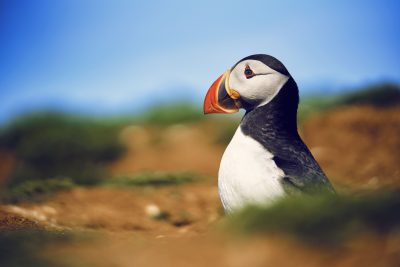
Wild Isles Episode One: Our Precious Isles premieres at 7pm on Sunday 12th March on BBC One and iPlayer.
Sir David Attenborough celebrates the rich variety of wildlife that exists in the British Isles and explains why our small and uniquely positioned set of isles are so critical for the survival of species from right across the globe.
Filmed in extraordinary detail across the country, this episode reveals new behaviour from animals we think we know well, and from others whose existence here may come as a surprise. Killer whales hunt for seals in our seas, rare golden eagles scavenge in snowy mountains, puffins are chased by greedy gulls that try to steal their hard-won catch and sinister woodland plants hold unsuspecting insects hostage.
Interview with Hilary Jeffkins (Series Producer & Episode One Producer)
What would you hope that the audience will take away from watching the series?
I hope that after watching this series our audience will be wowed by the wildlife and spectacular places in Britain and Ireland but also that they get a strong sense of how fragmented and fragile they are. I want the audience to come away with a sense of pride and hope for the future too.
Why are Britain and Ireland globally important for nature?
Surprisingly, Britain and Ireland have some of the most diverse geology in the world and this bed rock has given us varied and unique habitats with some very precious wildlife. We are custodians to more than 50% of the world’s common bluebells and we have 85% of the worlds chalk streams*. Also, our position on the globe means that our isles are key places for migratory species that stop off to feed and breed – in the summer we are home to the world’s biggest colony of Northern gannets, 75,000 breeding pairs, and every year huge numbers of barnacle geese migrate our way to find food. This makes us globally important for nature. But despite this we are still one of least biodiverse countries in the world, making it important that we protect and restore the wildlife we have*.
Do you think people will engage with the extraordinary wildlife on our doorsteps as much as they have with natural history programmes about other parts of the world?
I think that people will be surprised by the wildlife on their own doorsteps and amazed by the behaviour. It is quite shocking to think that we have pods of killer whales, top predators, hunting seals in our seas and a large blue butterfly that tricks ants into caring for its caterpillars, by using deceptive sounds and smells. The wildlife that we think we know well still has some extraordinary hidden stories.
In Episode 1 there’s a scene where you filmed barnacle geese who come to a Hebridean island in the autumn and are hunted by white-tailed eagles. Can you tell us about how you filmed that scene?
White-tailed eagles hunting is a behaviour rarely seen in the wild and only snippets of this had ever been filmed before. Capturing the whole story required a co-ordinated team of specialist long lens cameramen and wildlife spotters. This included top wildlife cameramen John Aitchison, Jesse Wilkinson and Hamza Yassin. The white-tailed eagles ranged over vast areas on the island and beyond, so the team had to keep in close communication via walkie talkies, working for long hours in hides positioned at eagle hot spots around Islay. It took several trips and more than 70 days filming to capture the first ever complete sequence of wild white-tailed eagles hunting barnacle geese.
You also filmed Lords and Ladies plants that release a foul-smelling scent to attracts flies, what technology did you use for this scene?
We used a tiny amount of time-lapse to speed up the pollen when it was bursting out of the flower and the rest of the sequence was shot in real time over several days. Filming the flowers of Lords and Ladies was a challenge. The team, including world expert macro cameraman Alastair MacEwen, used specially developed lenses, and had to make tiny windows in the sides of the flowers to be able to see the structures within. Thermal cameras were used to capture glowing images of the spadix when it was heating up to lure in the flies. Pinpointing the exact time to film a hot flower was tricky! Each one only heated up for just one evening before it started to wilt the following day. A combination of carefully timed observation, plus the smell and warm feel of the flower when near our skin helped track them down. But it was worth the effort to see the woodland look like it was peppered with tiny candles.
